The slope of the sewer pipe is an important indicator for
When designing and installing the system yourself, it is important to understand what the slope of the sewer pipe should be and what consequences can be caused by mistakes in the process of work. To ensure the correct operation of the system, it is necessary to calculate all slopes very carefully from the very beginning, since it will be very difficult to correct errors in the future, especially if the pipelines are concreted or filled with soil.
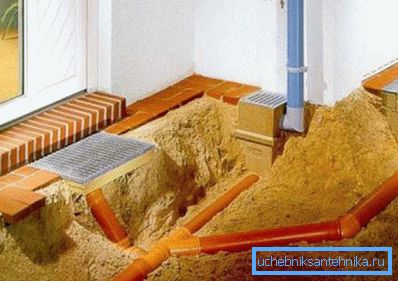
Documentation in accordance with which the work is done
To do work in accordance with regulatory requirements, you need to know what acts should be guided in the process of design and installation. At the moment, there are three main documents:
| SNiP 3.05.01-85 Internal sanitary systems | This document outlines the basic requirements according to which communications are arranged in all industrial and residential buildings. |
| SNiP 2.04.01.85 Internal water supply and sewerage of buildings | This regulation includes all the basic requirements and indicators to which the laid water and sewage networks inside buildings and structures must comply. |
| SNiP 2.04.03-85 Sewerage. External networks and facilities | This act covers all the necessary information and requirements for external work on the construction of communication networks. |
There are also a lot of intra-industry and departmental instructions, but all of them are drawn up in accordance with the requirements set forth in the above documents. It all depends on the characteristics of an object.
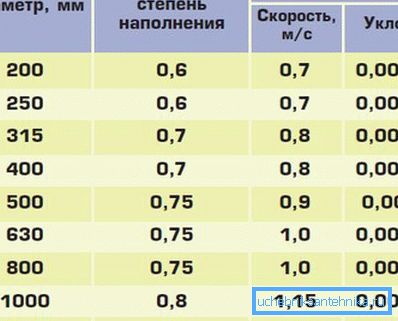
What should everyone who builds sewage know
In fact, by following a few simple recommendations, you can achieve excellent results without the involvement of professional experts. It is important to calculate the correct slope of the sewer pipes and fix them in the correct position (read also the article Depth of the sewage system - the main aspects of this issue).
Note! It is very important to maintain a uniform slope along the entire length of the pipeline, any deviations are fraught with the occurrence of blockages. If you choose an indicator, for example, 2.5 centimeters, then it should be from the beginning to the end of the section.
Important nuances to consider
Many of those who do the work with their own hands, mistakenly believe that it is better to make the slope of the sewer pipe more to improve the removal of wastewater.
In fact, the construction standards are clearly limited to both the minimum and maximum gradient, and violations of the values are undesirable on either side for the following reasons:
- Too small slope is fraught with low rate of outflow of fluid from the system, which can carry a lot of problems: sedimentation of solid particles on the walls and the rapid formation of plaque, which decreases the diameter through passage with time, which leads to blockages, overflow of pipes with a large volume of drains and leaks.
- If the maximum gradient is exceeded, the fluid will move very quickly., in view of which solid particles stick to the walls much more, as they do not have time to wash off with water. In addition, too rapid flow can lead to the disruption of hydraulic locks, and an unpleasant smell will penetrate into the room.
Determination of slope value
The slope angle of a sewer pipe directly depends on its diameter. In this regard, it is important to clarify that the thinner the pipe, the greater the slope should be, respectively, and vice versa: the larger the diameter, the smaller the angle required.

When calculating it is important to remember a few important rules:
- The angle is always measured in centimeters per meter running and is never defined in degrees. This is due to the fact that any error in the calculations can lead to problems, while checking the inclination in centimeters is much easier in terms of installation.
Remember! The generally accepted standards among specialists can be considered the value of 3 cm for a pipe with a diameter of 50 mm and 2 cm for pipes with a size of 110 mm. That is, if the length of the section is 5 meters, then when applying the first option, the difference between the beginning and the end of the pipeline should be 15 cm, the second - 10 cm.
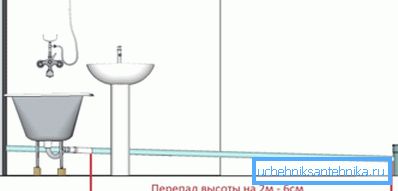
- Deviation from the above indicators is allowed within insignificant limits, it should be remembered that the slope of plastic pipes may be slightly less due to the fact that their inner surface is smooth, while asbestos-cement and metal elements must be laid exactly as required by the standards.
- On short sections, the slope may exceed the allowable, but too large angles should still be avoided.
- When laying on the street the correct angle of sewer pipes is especially important, so they are placed on a pillow of sand or rubble to prevent subsidence.
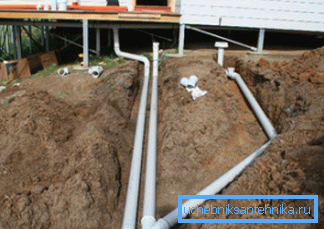
Important recommendations for work
Along with the exact setting of biases, it is important to remember a few basic rules to follow, this is a kind of instruction for avoiding problems in the future:
- You must try to use the minimum number of turns and joints.
- If it is necessary to equip a turn by 90 degrees, then it is better to do this with the help of two fittings at 45 degrees to ensure a smoother turn, especially since their price is low.
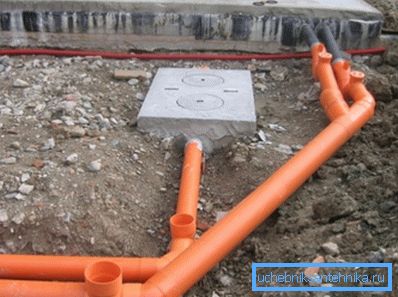
- The toilet is best located next to the riser.
Conclusion
Remember that the slope of the sewer pipe 110 mm should be less than that of the pipe 50 mm, this is a very important factor. We also recommend to watch the video in this article, it clearly explains some of the issues raised in the topic (also find out how the rain sewage system is designed).